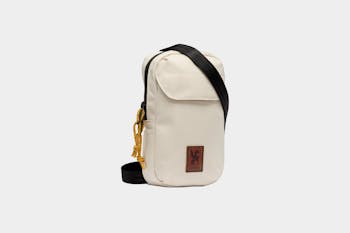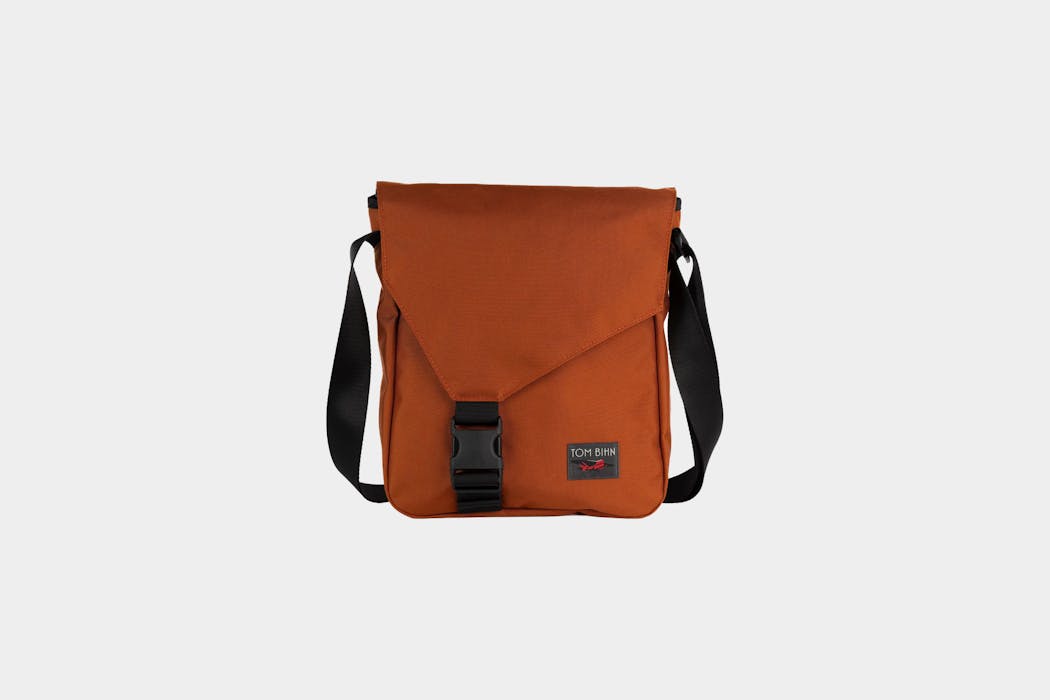Chrome Industries Ruckas Accessory Pouch Review
Despite its tall shape, the three-quarter zipper opening on the Chrome Industries Ruckas Accessory Pouch lets you more easily reach gear at the bottom.
Our Verdict
Save time. Get access to brief summaries of our reviews so you can browse and make decisions more efficiently.
Pros
- Wide zipper opening eases access to inner pockets
- Can be oriented vertically or horizontally
- Attachable to other bags as an accessory pouch
Cons
- Front pocket’s fabric welt makes access tricky
- Inner pockets’ vertical layout somewhat clunky to access
- Simple strap offers minimal yet acceptable comfort
Technical Details
-
Capacity
0.8l
-
Weight (lb)
0.26 lb (0.1 kg)
-
Dimensions
7.5 in x 4 in x 2.25 in (19.1 x 10.2 x 5.7 cm)
-
Notable Materials
Recycled Polyester, Polyester, Paracord, YKK Zippers, Unbranded Hardware
-
Manufacturing Country
Thailand
-
Warranty Information
Full Review
We have a sort of love-hate relationship with vertical slings. Their tall shape often doesn’t do well regarding accessibility since they make you stack gear. Want to get your earbuds at the bottom? You’ll have to dig out your keys first. Based on our experience, this makes it one of the more challenging types of slings to use for a daily carry.

While the Chrome Industries Ruckas Accessory Pouch uses this tall, vertical shape, it has a three-quarter zip in its favor, giving its main compartment a wide opening that lets you easily access its inner pockets. How easily, though? Let’s find out!
External Components
Right off the bat, what will probably strike you about the Ruckas Accessory Pouch is the heritage styling. More often than not, Chrome Industries’ gear has a very utilitarian look, which makes sense. They make a lot of active and professional-oriented bags for biking and photography, for example. In a more general sense, they have a very squarish shape, like with their Kadet slings and Volcan Backpack. The Ruckas Accessory Pouch, though? It’s much more everyday carry-friendly to look at. Walk into a coffee shop, and the barista will know you’re there to order, not to shoot some photos.

Do we like it? Oh yeah, we do. We like when brands offer variety because whether you fall between those camps mentioned above or somewhere in between, it’s always a win to have options. On that note, you get three colorway options to choose from at the time of writing: Black, Oil Green, and Natural. We tend to go for black colorways, but we switched it up and went for Natural because it contrasts nicely with the leather front logo. It’s unclear if this is vegan leather, though, in case that’s a deal-breaker for you.
The main fabric is 300-denier Poly Dobby, though the back is made of heavier 900-denier polyester. The former feels relatively soft and smooth despite what the grid ripstop-like pattern might suggest. It’s definitely not the most robust-feeling fabric we’ve tested, though over two weeks of testing hasn’t yielded any tears either. The fabric at the back is heavier because that’s the part of the sling that’s constantly in contact with you, so you’ll want more abrasion resistance for that area. Denier count drops significantly to just 15 for the polyester liner, but that’s par for the course for most liner fabrics.

The zippers are from YKK, a brand known for making reliable zippers. We’re not taking that fact for granted, though; fortunately, these zippers have operated without issue. The mustard yellow paracord pulls are a nice touch. It really caps off the Ruckas Accessory Pouch’s heritage styling, kinda like the cherry on top of the icing (the icing, in this case, is that leather logo, if you really want to ride that analogy).
The zipper track is a reverse coil. Hence, you don’t get that toothy look. This means rainwater shouldn’t seep in quickly in case you find yourself in one. Still, we suggest running for the nearest roof because there’s no weather-resistant coating, as far as we can tell. The front pocket does have a substantial fabric welt, but that’s the only concession you’re getting tangential to weatherproofing.

Something subtle but worth pointing out is the back panel padding. Small slings like these may settle for just the thick fabric, but we dig that there’s actually padding here. It makes a noticeable difference in carrying comfort, especially once the bag is fully packed out. Concentrating that heft into a relatively small sling like this is nicely offset by even a tiny bit of padding.
There are also two loops on the back panel in case you want to attach it as a pouch to a belt or bag with external mounting straps. We like that there are two of these loops since it offers a balanced mounting. Just having one can make it wobbly, especially if you only use a thin strap.
That said, we think the primary way to carry the Ruckas Accessory Pouch is via the sling strap. It’s a simple strap that attaches to loops at the corners using clips. Before we forget, we like how these loops sit right up against the back panel instead of sticking out. It’s a much cleaner look if you’re not using them to attach the strap, although the loops themselves are quite thin, so there’s a tradeoff in robustness as well. More importantly, the clips are somewhat tricky to hook onto the loops because of their low profile. Luckily for us, we’re mainly using the strap, so once it was on, we never took it off.

The strap itself is lightweight, and that’s mainly because of how thin it is. There’s no padding whatsoever, and that’s perfectly understandable given the Ruckas Accessory Pouch is a sub-one-liter sling (0.8 liters, to be exact).
Fit Notes

Comfort-wise, it’s less of a question about padding or straps and more of a question about orientation. As mentioned earlier, there are four loops where you can mount the strap, affording you the option of a horizontal or vertical orientation. The latter is the intended way since it positions the logo and the front pocket upright. This makes it our preferred method, and we just let it hang near the side or the back where it felt most natural.

There’s something to be said about the horizontal orientation, though. It’s also a viable option since the zippers go all the way down one side. This means you can have a much wider opening, which is very convenient if you carry relatively bulky items inside. Either carrying style you go with, comfort is acceptable given the strap’s simplicity, so go for what’s convenient for you.
Inside The Sling
The Ruckas Accessory Pouch has two compartments, but let’s check out the one at the front first. It is meant to be a quick stash pocket for your smartphone. It’s deep and relatively narrow, but it does fit an iPhone 13 without a problem. Accessibility-wise, though, the fabric welt is quite tedious to move out of the way each time we want to take the iPhone out. We use our phones a lot (and we bet you do, too), so this isn’t an ideal spot for it.

However, less often used everyday carry items like earbuds are more suitable for this pocket. We don’t have to dig them out as frequently, but keep in mind that small gear like earbuds will sink to the bottom. You have to shimmy them out from the outside all the way to the top. In other words, try not to stash anything too small, or you’ll have to wiggle them out as well.
The main compartment’s three-quarter zip design really helps with interior visibility, regardless of the orientation you choose. Other tall slings have zippers that only go halfway down, which is okay for the most part. However, the three-quarter zip style pairs really well with a tall sling like this because it lets you get to gear at the bottom more easily. Plus, the three-quarter zip makes more sense once you see the organization inside.

On the back side, there are two liner pockets nested on top of each other, with three elastic loops adjacent to the bottom pocket. The three-quarter zip lets you access those elastic loops even when it gets crowded around the top area. On the other hand, those nested liner pockets are a bit tight when we’re trying to fit a minimalist wallet. When we say nested, they’re also overlapping, so packing out the top one can make the bottom tight.
Across on the other side is a mesh pocket that goes all the way down the bottom. You can put your smartphone here or in the top liner pocket from before (it also goes entirely down). We use it to store keys since it’s the biggest inner pocket. That said, if you plan on using the mesh pocket for anything bulky, we don’t recommend putting a phone in the front pocket to preserve that side’s flexibility.
In case you’re wondering, having the Ruckas Accessory Pouch in horizontal mode does make everything inside more easy to see. However, it also puts the pockets sideways, so access might be trickier this way. The front pocket is also sideways, so we don’t recommend it.

Overall, utilizing the organization takes some planning if you want minimal impact on accessibility. The layout is a bit awkward with those nested liner pockets, and it’s all accentuated by the Ruckas Accessory Pouch’s vertical shape. As usual, gear arrangement stacks from the bottom to the top, though fortunately, the three-quarter zipper access minimizes most of the inconvenience.
Usage Timeline
Condition: Excellent
- Digging the heritage-like style
- Interested to see how useful the front pocket is
- Material feels durable and sturdy
Condition: Excellent
- Getting gear out of front pocket is a little tight
- Versatile to wear because of the removable/movable strap
- Takes a bit of finesse to configure gear in the slim design—can get clunky very quickly









Get your questions about the Chrome Industries Ruckas Accessory Pouch answered from our team and the Pro Community right here on the page. Plus, join discussions with other members about gear, guides, and more.
Join Pack Hacker Pro or, Sign In